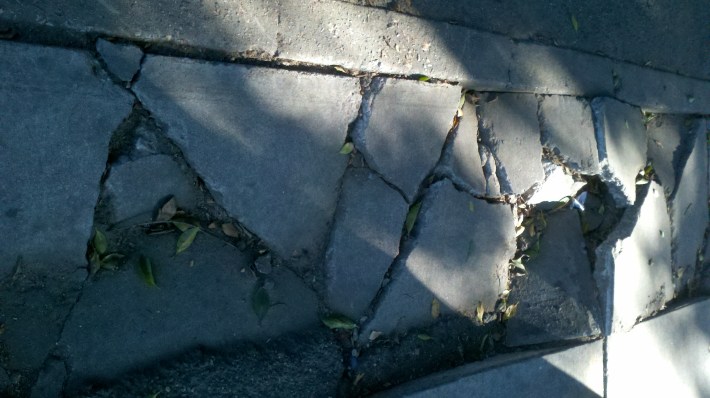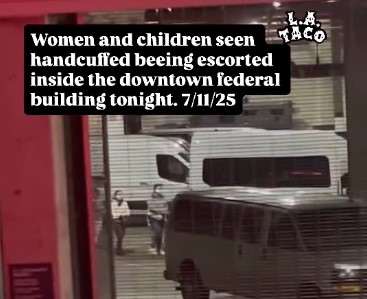
As previewed last week, the Los Angeles City Council's Public Works and Budget Committees held a joint meeting yesterday to discuss and decide on the future of repairing L.A. City sidewalks. In settling the Willits vs. City of Los Angeles lawsuit, the city is committing to spend $1.4 billion - over the next 30 years - to fix tree-damaged sidewalks.
Here are some observations from yesterday's #LASidewalks hearing:
1. Nothing is happening fast here
Do not expect your local damaged sidewalk to be fixed tomorrow. The outline of the settlement has been decided, but the details are still very much in flux.
After three hours, the only actions to come out of yesterday's hearing were instructions to city staff to report back - on a number of parameters: a proposed sidewalk prioritization scheme, a possible cap on per-parcel costs, alternate materials, workforce development, and what resources would be needed for environmental review.
Even when the settlement and work plan are finalized, the city will have a one-year period to prepare for the program - but that clock is not even ticking yet.
2. Many Issues Still To Be Decided
Though the City Administrative Officer (CAO) was requesting the council decide twenty-four specific decision points (see staff report [PDF]), none were actually decided. No votes were taken. Councilmembers appear to be split on a number of issues:
- Funding: Though the city has committed to $1.4 billion, it is not clear where the funding comes from. Theoretically, this could be pushed back to future budget discussions.
- Residential vs. commercial property: The CAO "fix and release" proposal would only pertain to residential sidewalks. This "residential" is not just where people live, but it would be the city Bureau of Sanitation's trash-service definition of residential property, which basically means single family homes and up to fourplexes. Apartment buildings and condos would not be residential, but commercial. Many councilmembers expressed interest in including both commercial and residential sidewalks, but opening up a repair program more widely could create a situation where there is not enough funding to go around, hence potentially triggering greater needs for prioritization and managing a request queue.
- Using Incentives: Especially for commercial property, councilmembers expressed interest in leveraging city funding in the form of matching homeowner funding. The city might offer, for example, a 50/50 match for commercial property repairs. City funding would pay for half (or some undetermined percentage) and owners would pay the rest. Past match programs tended to favor richer communities, so there might need to be some sort of means test to accompany this sort of program.
- Capping parcel expenses: The cost of sidewalk repair varies a lot, depending on the extent of damage, and the length and width, and other factors. One example that was repeatedly mentioned was that commercial sidewalks in parts of downtown Los Angeles are structural roofs over underground rooms and repairing those types of sidewalks would cost orders of magnitude more than typical sidewalks on top of soil. Creating some sort of cap, a maximum city cost for repairs for any given parcel, could ensure that repairs are distributed broadly around the city.
- How to handle sidewalks that are neither city nor private: There are various governmental entities responsible for repairing their own sidewalks, for example: schools, federal courts, public universities, etc. Theoretically, the city of L.A. is responsible for citing these entities to get them to repair sidewalks, but, to date, the city hasn't inspected or cited other jurisdictions. Some councilmembers urged leniency for other cash-strapped agencies like LAUSD.
- Inventory: Though livability advocates are pushing for an inventory of city sidewalks, which the city estimates would cost around $10 million, there is no clear consensus for this on the council. There is not even a central tracking system for broken sidewalks. Various city agencies maintain lists: 211, City Attorney, Bureau of Street Services, and various council offices. For repairs to proceed, the city needs to determine how it will track sidewalk conditions, requests, and projects.
- Environmental Impact Report: For a 30 year $1.4 billion project, the city is anticipating the need to perform environmental studies (EIR - environmental impact report) required under California environmental law (CEQA - California Environmental Quality Act.) Though this was recommended by the CAO, it is not a go just yet. Councilmembers were requesting that sidewalk repair work get underway while the EIR is being prepared.
- Impacts to Trees, Water, and Environment: Speaking of environmental impacts, there were a lot of concerns raised about impacts to tree canopy, rainwater runoff, drought, climate, etc. Various councilmembers urged the use of alternative materials, green infrastructure, tree preservation, modified tree well standards, etc. Though it makes a lot of sense to address these concerns during sidewalk repair projects, it is unclear where any additional funding would come from.
- Equity: Broadly, enforcing property owner responsibility for the cost of fixing and maintaining sidewalks is likely to be less successful in neighborhoods with less resources. Though there was a lot of rhetoric about looking out for the poor church vs. the luxury condo building, there was very little in the way of programmatic features to ensure equity. Ultimately the only proposals were that city staff determine how to include local and small businesses incentives in contracting sidewalk repair work.
3. Clarifying Points Of Confusion
There were still many council questions about what the settlement funding can be spent on:
- Can funds add sidewalks on streets where there are none? No.
- Can funds fix public stairways? No.
- Can the city fix its own sidewalks around city parking lots? Yes, but actually there is already another budget item for that, with repair work underway.
- If sidewalks are broken, but not so bad, do they really need to be fixed? Yes, especially for city property. There are very specific ADA standards: for example a quarter-inch vertical gap or a half-inch horizontal gap qualify as a failed sidewalk.






